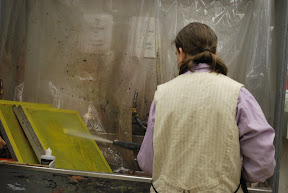Profile
Sydney Joslin-Knapp, Brandi Dale, Tony Hoogsteden, Ray Graetz, Rosie Rodriguez, Tim Brown, and Whitney Taylor with the assistance and oversight of resident artist Katherine Mann and student artist Emily Burkman are creating large-scale paintings on paper and canvas with splashes of acrylic paint, patterns, block prints, and more.
Links
Katherine Mann
The Blue Sky Project
To Me, You Are A Work of Art (Rodney)
Foxcroft Video Installation (Malic)
DaytonPaperStarlings (Lisa)
I look closely and I see that I have changed (Alan)
Archive
Photos by: Whitney Taylor
Layout by: vehemency
Wednesday, July 22, 2009, 3:31 PM
Linoleum prints and silkscreens
 Over the past two or three weeks, we've been experimenting with printmaking techniques and incorporating them into our large painting (and an update on that project is coming soon!).
Over the past two or three weeks, we've been experimenting with printmaking techniques and incorporating them into our large painting (and an update on that project is coming soon!).Rosie wrote in a previous post about how we came up with images for our linoleum block prints. After deciding on our final images, we redrew them onto the blocks with pencil or marker. Then, using Speedball linocutters, we carefully carved and gouged around those areas we wanted to show up as blocks of color. Linoleum block printing is a relief process, meaning that the topmost surface takes the ink, like a rubber stamp. Even thin lines had to be created with two or more cuts, since we had to cut around the line! (Think about that next time you see a delicate Japanese woodcut! They were done in the same way.)
Typically, a block print is taken by laying a piece of paper on top of the block and rubbing with a spoon, baren, or other smooth and slightly rounded tool until the ink transfers from the block to the paper. However, we printed our blocks like stamps because we were using heavy brown craft paper, which is too thick to accept a dense transfer of ink with a baren. Our stamping worked pretty well!
 Next we attempted silkscreen printing, which utilizes a totally different process to create reproducible images. A silkscreen consists of a frame and a porous, though tightly woven, silk screen. Using both tape and contact paper (though screen filler and photo emulsion are more typical artist's tools), we made stencils by masking off areas of the screen. By applying ink and pushing it through the open parts of the screen with a rubber squeegee, we got our prints!
Next we attempted silkscreen printing, which utilizes a totally different process to create reproducible images. A silkscreen consists of a frame and a porous, though tightly woven, silk screen. Using both tape and contact paper (though screen filler and photo emulsion are more typical artist's tools), we made stencils by masking off areas of the screen. By applying ink and pushing it through the open parts of the screen with a rubber squeegee, we got our prints!And then we had to clean up...
